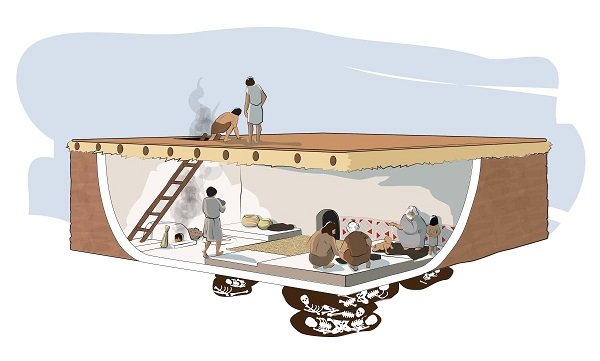Çatalhöyük: Possibly The World’s Very First City
by Ivan Farkas
From circa 7400 to 5200 BCE, Çatalhöyük thrived as one of history’s first recorded cities, nestled on the Anatolian Plateau next to the modern city of Konya, Turkey. No, I didn’t slip and fall on my keyboard; that’s how it’s spelled. By the way, for the purposes of scoring a $5 gift card on Ancient Mesopotamia Quiz Night down at the pub, it’s pronounced “cha-tal-hay-OOK,” meaning “forked mound.” You know, because the city was situated on two mounds, presumably of the forked variety.
The proto-city was exciting primarily for the ways it ushered in multiple humanistic revolutions. For starters, it demonstrates a shift from mere villages to actual agglomerations — which is just a nerdy way of saying it wasn’t simply a place where a bunch of hunters and gatherers ... gathered. It was a centralized location where full-on industries and businesses intersected, to maximize efficiency and reduce cost. You know, like in a city.
Yet Çatalhöyük didn’t exactly resemble the images conjured by the word “city.” Sure, it contained the structural unit of all habitation centers: buildings. But these mud brick homes were neither separated by streets nor arranged in a recognizable pattern.
Instead, they formed a honeycomb-like structure — each house sweatily pressed against its neighbor. You’ll also notice a plethora of holes. That’s because there were no doors. Inhabitants entered their homes from openings on the roof, comedically announcing “Luuuuuuuuucy, I’m hooo-ooome,” while clumsily stumbling down a ladder.
And because Çatalhöyük had no streets or boulevards for citizens to traverse while browsing market stalls, gossiping, and shooting crooked dice in alleyways, the roofs served as hubs of municipal activity:
According to Ian Hodder, one of the excavation directors overseeing the dig site, Çatalhöyük’s society also appears to have been wonderfully egalitarian. The city had no rich or poor, and men and women equally shared duties, and enjoyed the same rights and treatment. They didn’t even appear to have had an individual leader. Although, Hodder also cautions that it was only a utopia if you fit in with everybody else. People that were too into feet were presumably forced out. Plus, they’ve come across a bunch of human skulls peppered with non-lethal dents, suggesting that weirdos who got out of line received a light stoning.
But when they weren’t hurling rocks at each other’s heads, Çatalhöyükians (Çatalhöyükites? Çatalhöyükinos?) decorated their houses with multiple motifs, marking a revolution of commonplace, everyday art. Among the most prevalent decorations were bucrania, a slick Latin-from-Greek term for an ox skull. It’s unclear if anybody threw rocks at those.
Sometimes the oxen skulls were covered in plaster and displayed on the walls — an early parallel to today’s ubiquitous, child-labor-produced “Live, Laugh, Love” signs above most suburbanites’ day-drinking nooks.
Also similar to now-folks, Stone Age individuals constantly redecorated their dwellings. The main room of a residence had its plaster renewed every month or season. Artists produced wall paintings, both geometric and figural, as well as sculpted figurines of humans and animals. Here’s an example of a titillatingly buxom and majestic Earth Goddess, seated on a throne with lioness-headed armrests. She may be giving birth:
NSFW?
But because we live in a world where people can’t even agree on nude clay figurines, some scholars believe her to be a prestigious matriarch-type VIP, who’d earned some social prominence.
If the idea of rooftop-livin’ seems antiquated to you, consider how much of Europe is now once again turning roofs into social spots, or “living labs." The idea is to explore sustainability and Earth-friendly civic solutions through projects like solar farms, rainwater catchments, art venues, or green spaces and gardens.
The Dutch port city of Rotterdam alone harbors 150 million square feet of rooftop real estate which has been terraformed into an actual park called Luchtpark Hofbogen. This is all a part of the European Creative Rooftop Network, which has chapters across the continent, including Antwerp, Barcelona, Belfast, Faro, and many more. Some cultural spaces offer mind-expanding opportunities, as per Nicosia’s big rooftop telescope for stargazing and accompanying astronomy talks. Now all they have to do is get rid of all those doors.
And yeah, considering the bulls’ skulls adorning most Texas adobes and automobiles, and how much I sometimes want to chuck small pebbles at Quentin Tarantino, the world of today looks surprisingly like the world of 7000 BCE Çatalhöyük.










